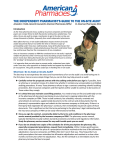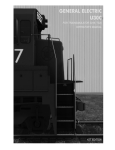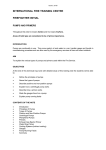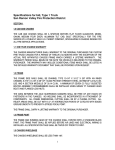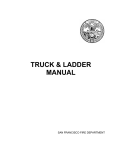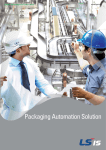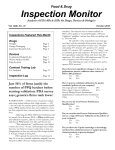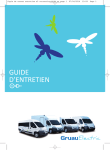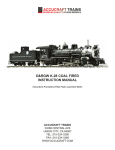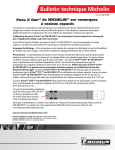Download FIREFIGHTING PROCEDURES
Transcript
DCN: 4.06.08 FIREFIGHTING PROCEDURES VOLUME 3, BOOK 2 March 15, 1997 LADDER COMPANY OPERATIONS: USE OF AERIAL LADDERS CONTENTS SECTION TITLE PAGE 1. Introduction ...................................................................................................... 1 2. Placement of Aerial Ladders (General) ......................................................... 1 3. 3.1 3.2 3.3 3.4 3.5 Placement Of Aerial Ladders (Fire Operations)........................................... Severe Fire - Person at 5th floor window........................................................... Severe-Fire - People at different windows ......................................................... People on fire escape, above fire........................................................................ Severe Fire - Narrow Frontage Building............................................................ Severe Fire - Large Frontage Building............................................................... 1 1 4 5 7 8 4. Ventilating With The Aerial Ladder.............................................................. 9 5. Operations For Removal Of Occupants Via Aerial ...................................... 11 6. 6.1 6.2 6.3 6.4 6.5 6.6 6.7 6.8 6.9 Officer Responsibilities.................................................................................... General ............................................................................................................... Selection of chauffeurs....................................................................................... Response patterns............................................................................................... Monitoring radio and Handi-Talkie ................................................................... Using radio and Handi-Talkie on arrival............................................................ Positioning apparatus ......................................................................................... Initial considerations and responsibilities at the fire scene ................................ Repositioning apparatus ..................................................................................... Officers of other than ladder companies ............................................................ 13 13 13 14 15 15 15 15 15 16 7. Chauffeur Responsibilities & Special Instructions ....................................... 16 8. Precautions........................................................................................................ 20 ©Copyright 1986 New York City Fire Department FDNY March 15, 1997 DCN: 4.06.08 FIREFIGHTING PROCEDURES LADDER COMPANY OPERATIONS: AERIAL LADDERS 1. INTRODUCTION 1.1 Aerial ladders may be used to effect rescue, entry, search, and ventilation. They may also be used to stretch hose lines to upper floors or roof; bridge a gap; operate hose lines from the ladder; ladder pipe operations; and as observation posts to assess conditions. When their need is evident upon arrival, they should be raised immediately. When their need is anticipated for later use, the ladders shall be positioned and set up as described in this bulletin. The chauffeur shall remain in the vicinity of the turntable until it is evident that the aerial ladder will not be required. 1.2 Almost 60% of our ladder companies are equipped with metal aerial ladders; the remaining companies have tower ladders. For the placement and use of tower ladders refer to "Fire Tactics and Procedures", Ladder Companies 6 (Tower Ladder Operations). 2. PLACEMENT OF AERIAL LADDERS (GENERAL) 2.1 The placement of aerial ladder apparatus (tractor-trailer rear mount) is dependent on four conditions: 2.1.1 Whether immediate rescue is apparent; or 2.1.2 Where no immediate rescue effort is required, the size of the frontage of the building to be covered in case of future need; or 2.1.3 Smoke, heat or fire causing an exposure that would endanger a victim, a member or the ladder; or 2.1.4 Area or street conditions that might hamper optimum positioning. 2.2 The outside ventilation man shall assist the chauffeur in proper placement of the apparatus before carrying out his other assigned duties. The apparatus shall not be backed up unless the chauffeur has the assistance or at least one guide man. 3. PLACEMENT OF AERIAL LADDERS (FIRE OPERATIONS) 3.1 Severe fire - A person at a window on the 5th floor apparently requiring assistance. (Figs. 1A and 1B) 3.1.1 Place apparatus 25 to 35 feet from the building for a good climbing angle. (Average city sidewalk is 13' from the building line to the curb and 35' from curb to curb). Place the apparatus in the center of the street, if possible. Due to the visibility restrictions of a closed cab (rear mount or tractor-trailer), the officer or outside vent man (OVM) (rear mount) can assist the chauffeur with the initial placement of the apparatus. Note: OVM indicates outside vent man. This would be the tillerman in a tractor-trailer company. 1 FDNY March 15, 1997 DCN: 4.06.08 FIREFIGHTING PROCEDURES LADDER COMPANY OPERATIONS: AERIAL LADDERS Figure 1A Approx. 25’-35’ sidewalk markings Lining up center of turntable with window, using sidewalk markings 3.1.2 Use the following guide for the correct placement and to avoid unnecessary stresses on the ladder. A. B. C. D. E. F. G. Slow down the approach of the ladder truck so that the lining up with objectives will be more accurate. Note carefully the window where the civilian is situated. Follow this line of windows vertically to the street. If possible, observe the relationship of windows to the lines in the sidewalk. (Other markers may be used to achieve the same purpose). Follow the closest sidewalk line to the center of turntable. Place center of turntable the same distance and direction from the sidewalk line as the window. (Fig. 1A tractor-trailer) Brakes, chocks, tormentors, power takeoff, etc., shall be engaged or properly placed. Note: Carry one set of chocks on each side of the apparatus. 2 FDNY March 15, 1997 DCN: 4.06.08 FIREFIGHTING PROCEDURES LADDER COMPANY OPERATIONS: AERIAL LADDERS Figure 1B 3.1.3 Raise, rotate and extend the ladder as per Apparatus Training Bulletins. `Lock the ladder in position. 3.1.4 Two methods that may be used to attain accuracy in lining up the ladder with a window are: A. B. For the well trained, experienced member, accuracy will be obtained by sighting along the ladder rail of the top section. For the trainee or less experienced member, this accuracy will be attained by sighting along the underside of the ladder beam on the top sliding section. 3.1.5 Recommended distance of the tip from the objective is 2" to 6". In case of rescue, use the 2" positioning so that the ladder will rest against the window sill after weight is put on it. This will remove the danger of motion to an uninitiated civilian. There is an exception to this recommended minimum distance. At a very extreme angle, e.g., placing the ladder to the roof of a seven story building, allow the ladder to barely touch the building. This will prevent excessive movement when a member climbs to a high elevation. During a member's climb, the ladder will be forced to rest against the building, which then stabilizes it. 3 FDNY March 15, 1997 DCN: 4.06.08 FIREFIGHTING PROCEDURES LADDER COMPANY OPERATIONS: AERIAL LADDERS 3.1.6 When positioning a ladder at a window, the placement must allow for unimpeded access and egress at this window. Therefore, the ladder tip should be less than 6" over the window sill. Refer to Section 8.5 for further details. 3.1.7 OVM assists the chauffeur in setting up and placing the ladder and climbs the ladder as soon as it is locked in position. 3.2 Severe fire - People at different windows. (Fig. 2) Figure 2 2A 2B 3.2.1 Remove those most seriously exposed first. (Figs. 2A and 2B) 3.2.2 When handling the rescue of occupants in windows of two floors vertically aligned, position and operate as explained under Section 3.1. 3.2.3 When only one aerial ladder can be used and endangered occupants are not in vertical alignment, place the turntable midway between locations. After removing those most seriously exposed, shift the ladder to complete the removal operations. (Fig. 2B) 4 FDNY March 15, 1997 DCN: 4.06.08 FIREFIGHTING PROCEDURES LADDER COMPANY OPERATIONS: AERIAL LADDERS 3.2.4 Proper placement of the aerial ladder may be affected by the above conditions and also by the wind, or by heat or flame issuing from below the rescue effort. This could cause the laddermen to risk positioning the ladder in a manner that would only be used in a serious fire situation. (Fig. 2C) Good judgment by the officers and firefighter in ladder placement will require them to be cognizant of these conditions. Figure 2C Change in apparatus placement due to wind condition 3.3 People on the fire escape above the fire. (Figs. 3A and 3B) 3.3.1 Place the ladder alongside the fire escape and against the building (2" out) with the tip about one to three feet above the balcony railing. This affords easier access to the ladder. Note: Remember the loss in height engendered by retracting the ladder to apply ladder locks. 3.3.2 Whenever possible, place the ladder on the least exposed side of a building. (Figs. 3A and 3B) If interior conditions permit, take the people into the least exposed apartment or other area and use the safest means of egress for their removal. 5 FDNY March 15, 1997 DCN: 4.06.08 FIREFIGHTING PROCEDURES LADDER COMPANY OPERATIONS: AERIAL LADDERS Figure 3A Figure 3B 3.3 People on the fire escape above the fire. (Figs. 3A and 3B) 6 FDNY DCN: 4.06.08 FIREFIGHTING PROCEDURES March 15, 1997 LADDER COMPANY OPERATIONS: AERIAL LADDERS 3.4 Severe fire - Narrow Frontage Building (30' or less in width). No people showing on arrival. (Fig. 4) 3.4.1 Position the turntable in the center of the building. (Fig. 4) 3.4.2 Ready the truck for raising the aerial. (Set brakes, tormentors, chocks, etc.) 3.4.3 This action shall be taken since the aerial ladder may be used, even though the immediate necessity for it is not evident. This procedure shall be adhered to for residential buildings - life hazard; commercial buildings-life hazard or possible use of ladder pipe; vacant buildings where operations may be facilitated. 3.4.4 When all ladder company operations can be performed efficiently with portable ladders (e.g. where involved and exposed structures are three stories or less in height) or street conditions allow for apparatus to pass another piece of apparatus, officers of ladder companies shall make every effort to maintain accessibility of nearby hydrants and to allow for in line pumping. In the former case, portable ladders are used to accomplish ladder company functions and in the latter case, both ladder and engine apparatus may be placed in positions that allow for optimal execution. Figure 4 30’ or less 7 FDNY March 15, 1997 3.5 DCN: 4.06.08 FIREFIGHTING PROCEDURES LADDER COMPANY OPERATIONS: AERIAL LADDERS Severe fire - Large Frontage Building (over 30') - No people showing. (Fig. 5A and 5B) Figure 5A 15’ 3.5.1 If no condition exists in front of building, requiring a definite position, place the center of the turntable approximately 15' from the side wall passed on your approach, as shown in Fig. 5A. A. Reasons: 1. The chauffeur may have to move the truck forward after initial placement. With a tractor-trailer aerial, the tillerman shall leave the trailer and tiller wheels lined up with the tractor. The chauffeur may now use a less experienced member to hold the tiller wheels straight while moving forward. Frontage will more often be clear of other apparatus than will street area behind since most engine companies make "back stretches" leaving building frontage unobstructed. If you approach the building in the same direction as the engine, the operation will be more efficient and coordinated. Backing up into position may require the movement of other apparatus or civilian vehicles and the chauffeur of a tractor-trailer requires the assistance of a tillerman. This is impractical and very time consuming. 2. 3. 3.5.2 When taking this position do not set up the truck for aerial ladder operations unless the fire is at the end of the building you have approached and the far end seems relatively safe. 8 FDNY March 15, 1997 DCN: 4.06.08 FIREFIGHTING PROCEDURES LADDER COMPANY OPERATIONS: AERIAL LADDERS 3.5.3 If there is a condition requiring possible aerial ladder operations or possible use of the ladder pipe (especially large commercial or public occupancies), as shown in Fig. 5B, then position the ladder for maximum coverage. Figure 5B Far End 3.5.4 3.6 Near End For fires covering an extensive floor area where more than one ladder apparatus will be needed, position to cover the portion of the building as ordered by the officer in command of the fire. If no orders are received, either at the scene or by radio, and contact cannot be made via Handi-Talkie with the other ladder company, be cognizant of the response pattern of this ladder company and position as follows: A. If the 2nd ladder company's response brings them into the street behind you, proceed to the far end of the building. B. If their response brings them into the fire street from the opposite direction, position at the near end of fire building. Roof access for serious fire in an isolated building. At an isolated building, when roof access and egress via conventionally positioned aerial ladders would be endangered or impeded by a serious fire condition, officers should consider using one of the aerial ladders by having it placed at a safe angle to the least exposed sidewall of the building. Officers and chauffeurs shall be guided by the manufacturer's instructions for safe operation of the aerial in a cantilever position (generally the maximum safe distance measured horizontally from the tip of the aerial to the center of the turntable is 40 feet). This placement requires positioning the turntable to the side of the building. Occasionally, obtaining this position may require placing the apparatus on the sidewalk or removing a minor obstruction. This use of aerial ladder requires that it be initially placed in the cantilever position with the tip fairly close to the building so that when placed under load it will either not touch or barely touch the wall. This should eliminate any twisting stress. Members should ascend or descend at well spaced intervals. 9 FDNY March 15, 1997 DCN: 4.06.08 FIREFIGHTING PROCEDURES LADDER COMPANY OPERATIONS: AERIAL LADDERS 4. VENTILATING WITH THE AERIAL LADDER 4.1 4.2 4.3 Ascertain the width of the area to be ventilated. Position the center of the turntable at the center of this span of windows. If there are obstructions hindering the use of the aerial ladder in this manner, position to get the largest number of windows. 10 FDNY March 15, 1997 DCN: 4.06.08 FIREFIGHTING PROCEDURES LADDER COMPANY OPERATIONS: AERIAL LADDERS Figure 6 windows to be vented 4.4 Time the ventilation; it is generally performed after the engine company has charged the hose line and is prepared to advance. Timing the ventilation is frequently critical. The Handi-Talkie should be used for coordinating the operation. For example, when a difficult search is in progress, premature venting may precipitate fire extension and endanger fire fighters or civilians. 4.5 Set up, raise, rotate and extend the aerial ladder as previously described. 4.6 Aim at upper window panels, just above the sash, and extend without hitting the sides or tops of window frames. (Fig. 6) 4.6.1 Caution: A. Only a slight extension through the window is required. This will avoid striking the ceiling, which could bind or damage the ladder. Now, lowering the ladder usually cracks the horizontal wooden sash allowing for complete ventilation of the window. When the angle becomes extreme, just lower the ladder so that the inside beam breaks the window. B. Under no circumstances shall ventilation of windows be effected by exerting lateral pressure with the ladder. Ventilation shall only be performed by extending the ladder through the window or by lowering the ladder into the window. 11 FDNY March 15, 1997 4.7 DCN: 4.06.08 FIREFIGHTING PROCEDURES LADDER COMPANY OPERATIONS: AERIAL LADDERS Be cognizant of creating an auto exposure which may allow fire to extend. 4.7.1 Remarks: A. Take necessary precautions to avoid injuries to people in the area. Glass may ride down hand rails or fall to the street. B. If a thorough primary search was not made earlier, due to fire conditions, areas vented in this manner shall be searched as soon as practicable. 5. OPERATIONS FOR REMOVAL OF VICTIM OR VICTIMS BY AERIAL LADDER 5.1 Position the apparatus as previously described. 5.2 OVM (Tillerman) sets chocks and tormentors. An alternative method, when manpower is available, is to have one man assigned to the inboard tormentor or tormentors and chocks \while the OVM takes care of the outboard side. This would enable the OVM to observe the building and be in a better position to ascend. 5.3 At night, the OVM uses the apparatus spotlight to pinpoint the victim and to reassure him. Since the cab spotlight is on the officer's side of the apparatus, the officer may have used it prior to leaving the apparatus. 5.4 OVM must observe the building continuously while chauffeur is operating the ladder. Someone may appear at another window or the trapped person may move to another location. 5.5 Prepare for a rapid ascent as the trapped people may attempt to climb onto ladder without assistance. Climbing the ladder while it is being extended or retracted exposes members to severe injury and may jeopardize the rescue effort. 5.6 OVM ascends the ladder followed by the chauffeur, climbs in window, assists victim out feet first to the chauffeur and then searches the area. The victim may be unable to inform him about other occupants. Note: OVM ascending first will keep chauffeur closer to the controls. (Only in an extreme emergency such as direct exposure to flame or great heat will the movement of the ladder with the firefighter and the victim on it be justified). 5.7 To descend with an ambulatory victim, place yourself one rung below the rung the victim is standing on. Descend in unison, i.e., right foot for right foot and left foot for left foot. Keep the victim between you and the ladder at all times and maintain physical contact with him. At steeper angles, have the victim grasp the rungs. This will facilitate your control. Talk to your victim; reassure him; praise his actions. Try to talk him into looking straight ahead or up and not down, as he might freeze on you. Those not familiar with ladders have a tendency to flatten themselves against the rungs and this will make your outside position easier. 12 FDNY March 15, 1997 5.8 DCN: 4.06.08 FIREFIGHTING PROCEDURES LADDER COMPANY OPERATIONS: AERIAL LADDERS If the victim panics, take control. Press him against the ladder with your body. Do not resume the descent until he is capable of continuing, If the descent is difficult or tiring, another firefighter should `back up' the member carrying or assisting persons down the ladder. His duties would be to support the first member and prevent him from slipping or falling backwards. Once they reach a position on the ladder where no danger exists, there is no need to rush. Note: When pressing the victim against the ladder be firm. After he has regained control of himself, resume your talking, coaxing and praising. 5.9 Removal is not considered complete until he has been assisted all the way to the ground. Do not leave him on the turntable. 5.10 If required, render first aid until relieved. Assist him to an ambulance if necessary. These actions shall not be taken if you are needed to assist in additional rescue operations. 5.11 When there are two victims to be removed, the order of removal is dependent on variables difficult to predetermine. In many instances, one of the people will have climbed out on the ladder before a member has reached this position and there will be no need to make a preferential determination as to removal. Occasionally one of the occupants will be aged, infirm, extremely heavy or hysterical and the other one ambulatory and less trouble to remove. The removal order should be based on the length of time needed to completely effect this rescue and the seriousness of the exposure to victims and members. 5.11.1 A serious fire in the front might cut off ladder descent in a short period of time. Both members assist the most helpless victim onto the ladder and the chauffeur assists the victim below the point of danger and then to the street. While the chauffeur is slowly descending, the OVM climbs onto the ladder and assists the more ambulatory person onto the ladder and complete descent is made. Note: In this instance, time is the prime consideration, in effecting a complete removal of victims below the danger point and in preventing the possibility of your retreat being cut off. 5.11.2 A serious fire in the rear, cutting off interior descent and no available front fire escape, presents another problem. Since the fire is not pushing out the front windows the time required to effect removal of victims is less critical. In this case, consideration can be given to the simple removal first and then concentrate on the difficult removal which will require two members. 13 FDNY March 15, 1997 DCN: 4.06.08 FIREFIGHTING PROCEDURES LADDER COMPANY OPERATIONS: AERIAL LADDERS 5.12 When there are more than two people to be rescued, the officer should assign an additional man to the rescue effort. However, in non-fireproof multiple dwelling fires, he should be certain that the roof man's critical ventilation and search assignment is neither delayed nor compromised. Therefore, with a 5 man company, the officer selects either member of his forcible entry team to assist the chauffeur and the OVM with the multiple rescue or removal. The remaining member moves with the officer into the fire building with the forcible entry tools and the extinguisher, as the roof man executes his assignment. The second ladder company should be informed of the need for supportive assistance, including outside ventilation. 5.13 Always carry small children down ladders. 5.14 In any rescue effort, where the fire may endanger victims, members or the ladder, serious consideration should be given to protecting them by directing water between the fire and the ladder. 6. OFFICER RESPONSIBILITIES 6.1 General. The officer, of necessity, has many responsibilities that require knowledge, practice, experience and a unified team effort for which he is accountable. Since he/she cannot directly supervise all facets of a ladder company operation, a great deal of planning and training of the unit is needed. Frequent practice will lead to required proficiency. 6.2 It is obvious that the selection of chauffeurs by company commanders cannot be based on one skill alone. Merely having driving ability or seniority is not adequate reason for selection. In addition, the member selected must have the ability to evaluate a problem and then make a sound decision to cope with it. They also must have a working knowledge of the duties and responsibilities of all members of first alarm ladder companies and how they are likely to execute their assignments under different fire situations. 6.2.1 Company commanders shall develop and train members before recommending them for Chauffeur Training School by requiring them to drive and operate the aerial ladder. This is performed during outdoor drills, inspectional activities and returning from alarms. 6.2.2 To enable back-up or relief chauffeurs to maintain their skills, numerous opportunities must be provided for them to drive and to operate the aerial. 14 FDNY March 15, 1997 6.3 DCN: 4.06.08 FIREFIGHTING PROCEDURES LADDER COMPANY OPERATIONS: AERIAL LADDERS In order to facilitate an efficient, coordinated operation, the officer of the ladder company should strive to enter the block after the 1st engine company and from the same direction. This is particularly important where street width or parked cars would prevent the engine from passing the ladder apparatus to reach the desired hydrant. If this happens, the enginemen must remove and stretch enough hose by hand to reach the entrance of the fire building and adequately cover the anticipated fire area. If the back stretch is used, the men will be less fatigued when they reach the fire floor. When necessary, two lines may be stretched in this fashion. This sequence of arrival will generally provide an easier stretch for the engine company as well as unobstructed access to a hydrant. At the same time it allows the ladder chauffeur to place his apparatus at the best location for access, search, removal of occupants or venting. 6.3.1 Response Considerations. A. Be aware of the general response patterns of nearby companies. B. Whenever possible, follow the first due engine when responding. This includes pulling over on a wide thoroughfare so that a first due engine company that is just behind the ladder company may pass. C. If the first to arrive engine is approaching the alarm location, stop at the corner and then follow it into the fire block. D. The second engine company to arrive pauses at the corner to make certain that a ladder company is in the block. E. If the second ladder company to arrive is moving into the fire block opposite the first engine company, the ladder company officer must verify that the engine has a hydrant before moving too close. The officer and non-committed members (excludes chauffeur or tillerman) approach the fire building on foot. F. For those occasions where the first engine company and the first ladder company enter the block from opposite ends, the following actions shall be taken: 1. The ladder apparatus shall be stopped just short of the hydrant that the engine company expects to use. 2. The ladder officer and the remaining members shall proceed to the fire building on foot. 3. The engine chauffeur, while using his apparatus to stretch hose, moves to the hydrant and positions his apparatus so that the truck can pass and proceed to the fire building. In some situations this may necessitate placing one wheel of the pumper on the sidewalk. G. Whenever an engine officer elects to use in line pumping (ILP), he must be certain that the ladder company has unobstructed access to the front of the fire building. 15 FDNY March 15, 1997 DCN: 4.06.08 FIREFIGHTING PROCEDURES LADDER COMPANY OPERATIONS: AERIAL LADDERS 6.4 Apparatus radio and Handi-Talkie should be monitored while responding. Orders or information may be received that will directly affect placement of the apparatus or the unit's operation at the scene. 6.5 On arrival at the fire scene, any information that would seriously affect the second ladder company's access to the fire area or the positioning of their apparatus, should be transmitted to them via Handi-Talkie or apparatus radio. 6.6 The officer shall be aware of both the placement of his apparatus and the possible positioning requirements of the second ladder to arrive. For example, conditions may require laddering for access or venting at an elevation higher than 80' as well as the use of a heavy caliber stream. 6.6.1 At vacant building fires, officers of aerial ladder companies shall consider the need for access and positioning of tower ladders in order to utilize their extinguishing capabilities. However, there are vacant building fires where the officer gives precedence to the positioning of his apparatus, e.g., A. A building not completely vacant. B. The officer receives information or has prior knowledge that part of this building is used by vagrants or squatters. C. The reach of his 100' aerial is required to expedite or execute certain tasks or assignments Note: In all of the above situations, he selects a position that permits achieving his objective while allowing for the placement and use of a tower ladder. 6.7 The officer is charged with the responsibility for proper placement of the ladder. Generally, when no delays are encountered, he should see that the chauffeur places the apparatus at the proper distance from the building and aligns the turntable with the objective. If a rescue is to be attempted, he should order the chauffeur and OVM to do so. He does not remain in the street as an observer. He proceeds to the fire area and directs an interior rescue attempt, if possible, as this is preferable to removal of the victim by aerial ladder. This does not relieve the officer (1st ladder company to arrive) of his responsibility for forcing entry into the fire apartment for the engine company and search of this apartment by members of his ladder company. (Generally, the preferential order for removal of people is via: INTERIOR STAIRS, HORIZONTAL EXITS, FIRE ESCAPES, LADDERS, LIFE SAVING ROPE.) 6.8 The officer shall ensure prompt and proper repositioning or parking of the apparatus after the fire is under control. This refers to aerial ladders not in use or whose use is not anticipated. 16 FDNY March 15, 1997 DCN: 4.06.08 FIREFIGHTING PROCEDURES LADDER COMPANY OPERATIONS: AERIAL LADDERS 6.9 Officers in command of engine companies, squad companies, rescue companies, chiefs' cars and special units, shall keep their vehicles from blocking out ladder companies from good ladder positions. 6.10 When ladder companies are called to the scene of an operation and it is evident that use of apparatus and aerials will not be required, officers shall order proper placement of apparatus, wheels chocked, doors and compartments locked. 7. CHAUFFEUR RESPONSIBILITIES AND SPECIAL INSTRUCTIONS 7.1 The chauffeur, while responding and at the scene, continually monitors Handi-Talkie because placement of the apparatus, ladder or his subsequent actions may be directly affected by orders or information so received. 7.2 The chauffeur shall, whenever practical, allow the first engine company to enter the block before he enters. For detailed information refer to Sections 6.3 and 6.3.1. 7.2.1 Approaching Alarm Box: When approaching a box location and there is no visible indication of fire on the avenue of approach, the chauffeur should slow down one intersection short of the box location and enter the intersection at a slow rate of speed. This will allow the members to look in the side streets for the fire or emergency. No apparatus shall cross any alarm box intersection unless sure of location of the fire or emergency or until certain that the alarm was unnecessary. This also applies to wide intersections, especially those with islands or road dividers, where going directly across these to the fire alarm box could cause considerable loss of time when it becomes apparent the fire is either to the right or left. Position and stop the ladder truck so that it can proceed right, left or straight ahead. 7.3 Occasionally, as the chauffeur approaches the fire building he will see hose line in the street. If possible, avoid running over the hose line. When it is necessary to traverse a charged line, it must be done SLOWLY. Make certain when positioning apparatus that no wheel or tormentor rests on the hose. 7.4 Never remove people via aerial ladder when they may be calmed and held safely at that location or removed via a safer means of egress. If, however, there is a time restriction due to fire conditions or other chauffeur responsibilities, then those occupants in danger must be removed. 17 FDNY March 15, 1997 7.5 DCN: 4.06.08 FIREFIGHTING PROCEDURES LADDER COMPANY OPERATIONS: AERIAL LADDERS Ladder chauffeur should remain on turntable when members have entered the building by aerial ladder and are in precarious positions such as: a floor over a heavy fire; the roof of a building with a heavy fire condition, etc. The chauffeur should keep alert as to the who, when, where of members using aerial ladder. Note: All officers should recognize the necessity for the chauffeur to maintain this position in the above situations. 7.6 When an aerial ladder has been committed to a roof position and is the only safe egress from that roof, e.g., a detached building or a building with no access to an adjoining roof, it should not be moved unless absolutely necessary. If it must be moved, direct radio communication must be made with members on the roof. It must also be evident that there is no immediate need for roof egress at the time and that this new critical task will not delay the prompt replacement of the aerial ladder at the original location. Units shall be informed of this temporary removal and the ladder must be returned to the same location as quickly as possible. This provides egress for a member who previously used the aerial ladder for access or for members who may have considered it as an alternate escape route. 7.7 When finished with the aerial ladder at a given location, always raise the bed ladder away from the building slowly to avoid whipping. Then extend the fly ladder in order to free ladder rung locks before retracting the aerial. 7.8 Ladder pipe operations as per Training Bulletin Apparatus L-1 and Evolution #21. 7.8.1 Remarks: A. B. C. D. If the street has a severe crown, make sure that the ladder angle does not exceed 70 degrees. The recommended procedure is to use two sources of water supply. This is to avoid the severe structural stresses the ladder would be subjected to, if it had a single supply source and the water flow was suddenly interrupted. For horizontal sweep, operate the turntable slowly and smoothly. This may be done efficiently and safely by cracking the proper hydraulic lock valve or manually rotating the turntable by using the crank handle and the hand rotation valve. When necessary, the ladder angle may also be changed by use of the proper hydraulic lock valve. It is of utmost importance that interior forces be removed from the area into which the ladder pipe will operate. This is the responsibility of the chief officer in charge of operations. Handi-Talkie communication facilitates this removal. Even after confirmation of the withdrawal of members from the area, as a warning, sweep the stream horizontally across and into the windows without hesitating or stopping. This acts as a warning for the infrequent situations where all members could not have been informed of ladder pipe operation or operation of other exterior streams. 18 FDNY March 15, 1997 DCN: 4.06.08 FIREFIGHTING PROCEDURES LADDER COMPANY OPERATIONS: AERIAL LADDERS 7.9 When laddering elevated structures or elevated roadways, be careful when extending over structures at an angle which could cause the ladder to be hit by a moving vehicle. The ladder should not extend over the roadway. In many instances, the road width will only permit raising the ladder parallel to the structure which removes the danger of extension over the roadway. Frequently a small nearby fire may be extinguished with a 1¾ line from the aerial ladder, thereby avoiding track entry by members. 7.10 There are many minor obstructions such as fences, shrubs, etc., which should not deter proper positioning when a serious life hazard is involved. 7.11 At drills and other routine outdoor activities, face the ladder apparatus in the direction of most likely response. This will save time when responding. 7.12 Street lamps, overhead wires, Christmas lights, or street festival lights could affect the positioning of the aerial ladder. Position as for normal operation. Raise the ladder out of the bed; rotate the ladder towards the roadway until clear of obstruction; raise, rotate, extend and place at the objective. (Fig. 7) Note: Any overhead obstruction could prevent normal positioning if the obstruction lies in the path of an imaginary line drawn from the center of the turntable to the objective. In this event, set up a short distance either side of this spot and proceed as mentioned. 19 FDNY March 15, 1997 DCN: 4.06.08 FIREFIGHTING PROCEDURES LADDER COMPANY OPERATIONS: AERIAL LADDERS Figure 7 OVERHEAD OBSTRUCTION 7.13 When placing the ladder to the roof, extend the ladder so that the tip is at least 5 feet above the point where the ladder comes in contact with the building. The reasons are twofold: first, the ladder is more readily found by members operating on the roof at night or under smoky conditions. The second reason is equally important. It is easier and safer for members to get on or off the aerial and this extra extension over the roof becomes even more critical when removing a civilian from this area. 20 FDNY March 15, 1997 7.14 DCN: 4.06.08 FIREFIGHTING PROCEDURES LADDER COMPANY OPERATIONS: AERIAL LADDERS Reasons for laddering the roof are: 7.14.1 The fire building is isolated and roof ventilation is required. 7.14.2 Other means of access to roof of fire building are unavailable or cut off and roof operations are evident whether for ventilation or rescue. 7.14.3 As a means of escape for operating force or civilian(s) guided by member(s). 7.14.4 Any other situation where its use would significantly improve operations. Note: When fire conditions might endanger members, civilians, or the apparatus, consideration should be given to laddering the roof of an adjoining structure for access and egress. 7.15 Hand rails are generally used when climbing the ladder with a tool. However, at steep angles greater safety is achieved by using the rungs. This shifts the member's center of gravity closer to the ladder providing greater control and a safer ascent or descent. 7.15.1 Frequently a member's assignment calls for two tools, one of which is the 6' hook. The hook is the only tool that need not be actually carried on aerial ladders portable ladders or fire escapes. The other tool (axe, halligan) is carried and the hook is extended arm's length overhead and hooked on a rung. It is not touched again until the member has climbed to a position where the top of the hook is about knee level. He stops, holds on firmly, and again moves the hook to a position arm's length above his head and to the side of the rung. In the diagram (Fig. 8) the member is climbing an aerial, that is positioned at a very steep angle. Ascending or descending, the hook should be placed on a rung of the ladder before the member steps on the aerial ladder. Refer to Ladder Companies 3, Page 55A, for additional information, re: carrying tools on ladders. 7.15.2 If an aerial ladder has attachments for securing tools at the tip, these attachments may be used when tools are required at the roof level. Note: Regardless of the method used to ascend the aerial ladder, always maintain enough hand control on the rails or rungs to insure safety. 7.16 Chauffeurs should be familiar with the operation of all other aerial ladders; engine company chauffeurs should be familiar with the aerial ladder operation of ladder companies that they respond with on first alarms. 7.17 When right angle positioning is prevented by other apparatus or parked vehicles which cannot be easily moved, an angled extension over the cab or trailer may be necessary. 7.18 Vacant lots or driveways adjoining the fire building may allow for better placement of the apparatus when overhead obstructions might interfere with operations. 21 FDNY March 15, 1997 DCN: 4.06.08 FIREFIGHTING PROCEDURES LADDER COMPANY OPERATIONS: AERIAL LADDERS Figure 8 Ascending or descending aerial ladder with tools 7.19 If fire is in an "H" or "U" type building and conditions do not mandate a specific position, avoid blocking the front entrance to the courtyard when it is apparent that a tower ladder may operate at that location. 8. PRECAUTIONS 8.1 Always make certain that the truck is properly set for ladder operations before leaving the cab. 8.2 The outriggers (tormentors) should be extended, placed and locked every time the ladder is raised. They should be set solidly on the fire building side. Place heavy planking under tormentors for soft pavement or where streams and/or run-off water may soften the ground. Note: Firmly setting outboard tormentors after the ladder is in position may cause them to jam when the ladder is returned to the bed. For this reason, set them slightly above the ground if placing them after the ladder is positioned. 22 FDNY March 15, 1997 DCN: 4.06.08 FIREFIGHTING PROCEDURES LADDER COMPANY OPERATIONS: AERIAL LADDERS 8.3 Substantial chocks should be placed to prevent movement of the apparatus. Carry one set of chocks on each side of apparatus. 8.4 Keep within the operating limits outlined in the manual for the particular apparatus. 8.5 Ladder rung locks shall always be engaged each time the ladder is raised, even if the ladder will not be retracted to line up the rungs. Our aerial ladders have rung spacing of 14" and have 4 sections. Therefore, there is a space of 42" for upper fly section travel between locking points. Place the rung lock control in the "on" position so that in the event of failure (cables or anchors), the sections will only drop to the next rung. 8.6 Place inboard side of the apparatus not more than 35' from the building line. 8.7 Operate the ladder controls with deliberate motions and smooth application of power. Jerky or erratic application of power is dangerous. 8.8 Do one thing at a time and in the proper operating sequence. Don't try to raise, rotate and extend the ladder simultaneously. 8.9 Avoid moving the ladder while men are on it, except to remove them from serious exposure or for an extreme rescue effort. 8.10 Do not EXTEND or RETRACT the ladder while men are on it. 8.11 Be careful of jamming the ladder under window sills or projections. This occurs when ladder locks are engaged, the ladder tip is even with a sill or projection and the ladder then is placed under load. 8.12 Use the life belt when operating on the aerial ladder. 8.13 Always consider the stability of any structure the ladder is placed against. Note: Be aware of unstable cornices, high tension wires or other objects that might endanger the men or ladder. 8.14 At night, keep the top of the ladder and the rungs well illuminated. For greater visibility, units could place reflective tape on the tip of the ladder and paint the tip white or yellow. 8.15 Avoid forcefully extending the end of the ladder against a structure. This includes pushing or lifting cornices and trying to open sealed windows in vacant buildings. 8.16 Never allow an aerial ladder to be used for stunting. 23 FDNY March 15, 1997 8.17 DCN: 4.06.08 FIREFIGHTING PROCEDURES LADDER COMPANY OPERATIONS: AERIAL LADDERS Avoid twisting the ladder by improper placement or by rotating when extended. On very windy days or at hilly locations, necessary laddering shall be done with extreme caution. As twisting weakens the ladder sections, it frequently precedes ladder failure. The following is an excerpt from WNYF, 1st Issue, 1963: "Twisting has a weakening effect on the ladder sections. Actually, twisting is the first step to ladder collapse. Twisting is likely to occur in a high wind, or when the turntable is not directly opposite the objective (one beam engages the roof or balcony first). When the load is applied, the ladder twists until the other beam also contacts. This may be accompanied by beam sliding laterally on the objective (any undue lateral stress should be avoided). Good judgment on the part of the operator is important. Normally, the recommended practice is to avoid resting the ladder beams on the objective before the load is applied. When load is applied both beams should gently rest on objective, both beams engaging at the same time." 8.18 Always have the chauffeur remain close to his truck while the aerial is in use. For extended operations or when the turntable will be left unattended, disengage the power-take-off in order to prevent accidental movement of the ladder. 8.19 Keep unauthorized persons off apparatus at all times. 8.20 In cold weather, keep hydraulic systems operating intermittently to prevent sluggishness or freezing; return the ladder to the bed as soon as possible to prevent icing; try to position the ladder to avoid water spray. If ladder becomes coated with ice, try to avoid movement before defrosting. To remove ice, first free rungs and ladder rung locks, then trussing and then the main beams. Most of the following statements (from WNYF, 4th Issue, 1964) have been condensed or rephrased. 8.20.1 Ice accumulations on an unsupported aerial ladder under certain conditions may lead to twisting and possible collapse of the ladder. 8.20.2 When ice prevents the chauffeur from raising the aerial ladder away from a building, the hydraulic mechanism may be assisted by placing a portable ladder under the extended ladder and using a number of men to exert additional pressure. Care must be taken to avoid injury to the men or damage to either ladder. At a high ladder angle, consider exerting additional pressure with a utility rope. The rope is tied near the tip of the ladder and men on the roof or in the window of a building across the street pull the rope taut in order to assist the hydraulic power. 24 FDNY March 15, 1997 DCN: 4.06.08 FIREFIGHTING PROCEDURES LADDER COMPANY OPERATIONS: AERIAL LADDERS 8.20.3 When ice prevents retraction of ladder sections, care must be exercised to avoid damaging the rungs or weakening the cables. Ladder rung locks must be released and in the proper position. This requires personal observation of each set of rung locks to determine if they are completely free of rungs and if any have to be secured in the proper position. This may require tying with wire or cord. A higher ladder angle will assist retraction. As only a fraction of available hydraulic pressure is used for retraction a manually operated valve allows for application of much greater pressure. However, this de-icing valve should be operated only by or under the supervision of a Department Mechanic. 8.20.4 Deleted 8.20.5 Under icing conditions, the Seagrave ladders require careful attention to assure proper cable tracking on the drum. 8.20.6 A heavy coating of prescribed lubricant will inhibit the formation of ice at critical points. This lubricant will also facilitate deicing. 8.20.7 In sub-freezing temperatures, drain ladder pipes, hose, piping, siamese connections, etc., as soon as the stream is shut down. 8.21 Never move the truck with tormentors in contact with the ground. 8.22 Never move the truck with the ladder raised to one side. Retract the sections substantially and turn the ladder parallel to its bed. 8.23 Always properly secure hose lines to the ladder, taking care that hose straps do not interfere with the operation of the ladder sections. Don't allow hose to be passed through rungs. 8.24 Be certain that the ladder locks are off and the sections have been extended to free the rung locks before applying power to lower the ladder. The ladder locks should be checked frequently for proper engagement (e.g. outdoor drill). 8.25 Report any difficulty with the ladder to the responsible officer. 8.26 Provide the care and inspection required by the Regulations and the service manual for the apparatus. 8.27 Members at the pedestal position shall insure the following safeguards and actions are taken BEFORE placing aerial into operations: A. The area immediately around the turntable be designated a Danger Zone. (Turntable Platform) B. Danger Zone around turntable be clear of members, tools or any impediments before rotation of aerial. C. If a firefighter is to climb the aerial ladder at the start of an operation, he or she shall be in position on the turntable before the aerial ladder is to be raised and rotated. BY ORDER OF THE FIRE COMMISSIONER AND THE CHIEF OF DEPARTMENT 25



























